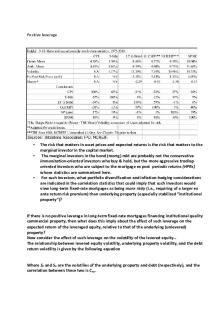FIN 670 Positive leverage PDF

| Title | FIN 670 Positive leverage |
|---|---|
| Author | Caroline Gomez |
| Course | Real Estate Finance |
| Institution | St. John's University |
| Pages | 2 |
| File Size | 161.1 KB |
| File Type | |
| Total Downloads | 22 |
| Total Views | 136 |
Summary
For this course, you will have more than 1 lecture every class, this class notes will help you study for the final project (exam 3), worth 30% of your grade...
Description
Positive leverage
• •
•
The risk that matters in asset prices and expected returns is the risk that matters to the marginal investor in the capital market. The marginal investors in the bond (mortg) mkt are probably not the conservative immunization-oriented investors who buy & hold, but the more aggressive tradingoriented investors who are subject to the mortgage ex post periodic returns (HPRs) whose statistics are summarized here. For such investors, what portfolio diversification and inflation-hedging considerations are indicated in the correlation statistics that could imply that such investors would view long-term fixed-rate mortgages as being more risky (i.e., requiring of a larger ex ante return risk premium) than underlying property (especially stabilized “institutional property”)?
If there is no positive leverage in long-term fixed-rate mortgages financing institutional quality commercial property, then what does this imply about the effect of such leverage on the expected return of the leveraged equity, relative to that of the underlying (unlevered) property? Now consider the effect of such leverage on the volatility of the levered equity… The relationship between levered equity volatility, underlying property volatility, and the debt return volatility is given by the following equation
Where SP and SD are the volatilies of the underlying property and debt (respectively), and the correlation between these two is CPD.
How can borrowing increase volatility while actually decreasing the risk of the equity?... Summarizing the question of “positive leverage”: • Ex post historical periodic returns statistics suggest there may be little positive leverage on average, • And that risk as the capital market cares about it may be nearly as great in long-term fixed-rate mortgages as in underlying (unlevered) property equity, at least for stabilized “institutional quality” commercial property. But: • These ex post returns statistics may skew the picture due to: • The particular historical period covered includes a long secular reduction in interest rates (declining inflation), which may have caused average realized ex post returns to have substantially exceeded the corresponding ex ante expectations; • Data problems in indices of commercial mortgage HPRs (notably, difficulty accurately quantifying the conditional loss severity portion of the credit losses computation) may cause those indices to overstate actual average achieved mortgage returns. • Most investors seem to generally believe (subjectively) that positive leverage exists ex ante in the total expected returns, e.g.: E[RP]mortg ≈ 150bp-300bp; E[RP]prop ≈ 300bp-400bp....
Similar Free PDFs

FIN 670 Positive leverage
- 2 Pages

Leverage-Effekt
- 1 Pages

STRUKTUR MODAL DAN LEVERAGE
- 26 Pages

MANAJEMEN KEUANGAN : LEVERAGE -
- 23 Pages

Chapter 6 Operating leverage
- 1 Pages

FIN 4 - FIN 4
- 7 Pages

positive relationships
- 4 Pages

FIN 3 - FIN 3
- 7 Pages

Libertà positive
- 15 Pages

Positive Parenting Plan
- 5 Pages

Positive Personal Qualities
- 1 Pages

Slavery- A Positive Good
- 3 Pages

Positive consumption externality
- 1 Pages
Popular Institutions
- Tinajero National High School - Annex
- Politeknik Caltex Riau
- Yokohama City University
- SGT University
- University of Al-Qadisiyah
- Divine Word College of Vigan
- Techniek College Rotterdam
- Universidade de Santiago
- Universiti Teknologi MARA Cawangan Johor Kampus Pasir Gudang
- Poltekkes Kemenkes Yogyakarta
- Baguio City National High School
- Colegio san marcos
- preparatoria uno
- Centro de Bachillerato Tecnológico Industrial y de Servicios No. 107
- Dalian Maritime University
- Quang Trung Secondary School
- Colegio Tecnológico en Informática
- Corporación Regional de Educación Superior
- Grupo CEDVA
- Dar Al Uloom University
- Centro de Estudios Preuniversitarios de la Universidad Nacional de Ingeniería
- 上智大学
- Aakash International School, Nuna Majara
- San Felipe Neri Catholic School
- Kang Chiao International School - New Taipei City
- Misamis Occidental National High School
- Institución Educativa Escuela Normal Juan Ladrilleros
- Kolehiyo ng Pantukan
- Batanes State College
- Instituto Continental
- Sekolah Menengah Kejuruan Kesehatan Kaltara (Tarakan)
- Colegio de La Inmaculada Concepcion - Cebu


